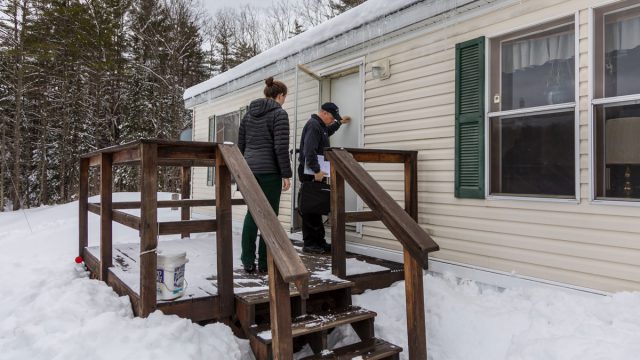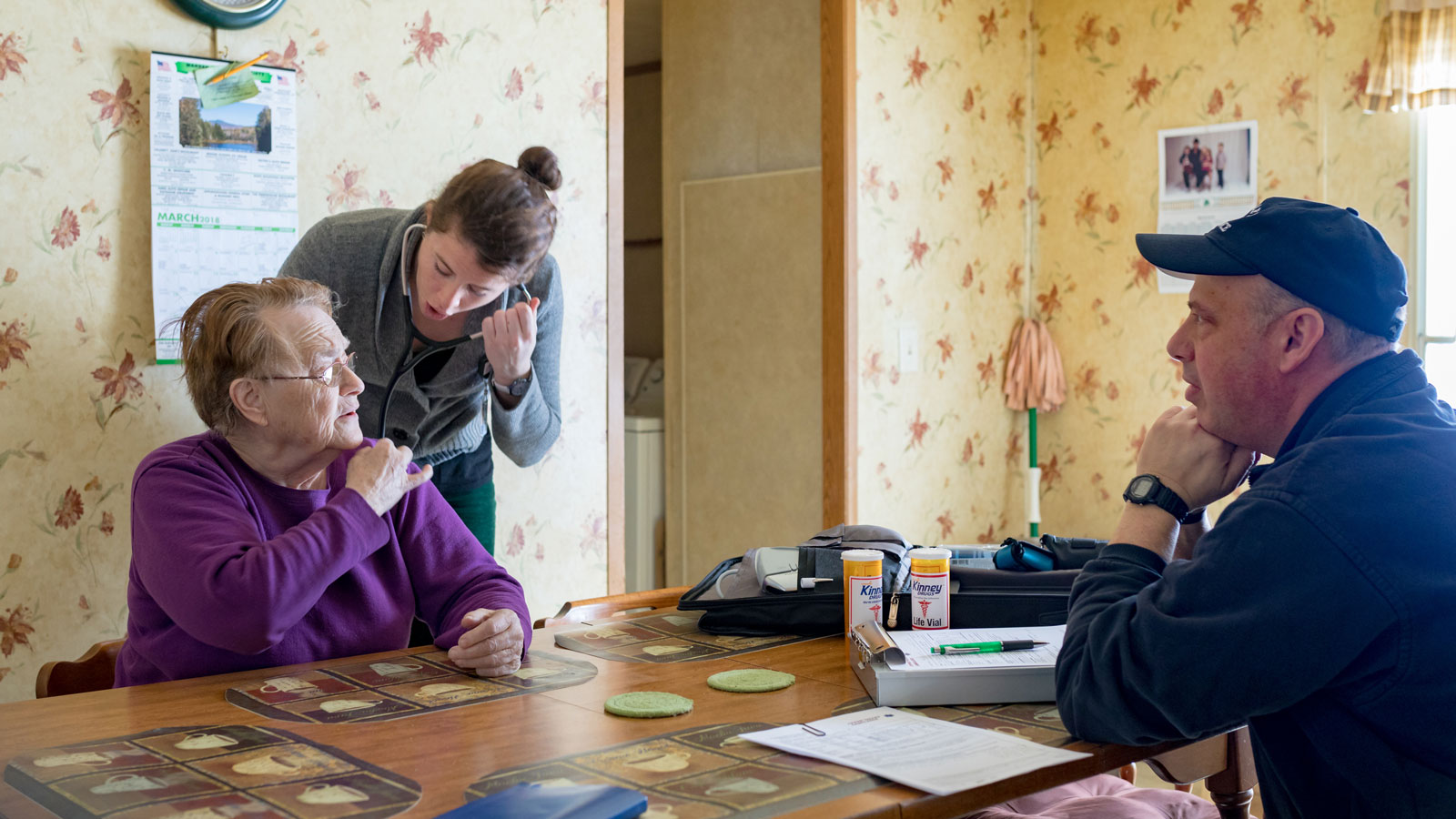
Years of working as emergency medical technicians (EMTs) in rural New England gave second-year Geisel students Nick Valentini '20 and Karissa LeClair '20 shared insight into the challenges patients face at home, and the need for a home healthcare resource that is readily available and of no cost to this vulnerable population.
“Thinking about this project, I realized it was a good way to raise awareness among medical students and healthcare providers about the capabilities of first responders,” Valentini says. “And to bring emergency medical service (EMS) in contact with medical providers so they can work together to provide continuity of care.”
The pilot Community Paramedicine project, developed and implemented by Valentini and LeClair, partners medical students with Upper Valley Ambulance paramedics and EMTs to make house calls—the first partnership of its kind in New Hampshire. Rooted in compassion-centered medical care, the project took shape while both Valentini and LeClair were Rodis fellows. The Geisel School of Medicine Pano Rodis Fellowship in Compassion-Centered Medical Care encourages medical students to design and implement an independent project that addresses compassion-centered care.

“As far as I know, there aren’t any medical students partnering with ambulance services to address this healthcare issue,” says Clay Odell, executive director of Upper Valley Ambulance. “I’m really pleased that Geisel gave Nick and Karissa this opportunity—it’s exciting and rewarding to be part of this innovative program.”
Community paramedicine is a new and emerging field that allows EMS staff to provide routine primary care to underserved rural populations. Some rural patients who lack easy access to primary care use 911 services for non-urgent healthcare, which can burden EMS services. Community paramedicine eases this burden by proactively meeting the needs of these rural residents. Maine, an early adopter of this concept, has established several licensed programs in the past few years. The first licensed paramedicine program in New Hampshire is in southeastern Strafford County—a hospital-based EMS system where hospital paramedics work in tandem with the hospital’s primary care practice permits.
“Providing preventative care is a great bridge between primary care and emergency medicine,” LeClair says. “As medical students, we have no idea what patients experience in their homes and the same is true of physicians who send patients home with instructions to either take medications or modify their behavior without understanding that there may be obstacles to patients complying with those instructions. Nick and I saw these obstacles as EMTs, so we wanted to bring that awareness to medical students while also being a resource for patients.”
After more than a year of planning, which included reaching out to communities in the Upper Valley, acquiring state licensing, recruiting medical directors for both emergency medicine and primary care, creating a partnership with Dartmouth-Hitchcock Medical Center’s (DHMC) Lyme Clinic, and establishing an elective course for Geisel students, the pilot Community Paramedicine program launched earlier this year in two communities—Piermont and Orford. A winter term curricular elective allows medical students to accompany paramedics on house calls.
Tom Trimarco, MD, who is the EMS medical director for DHMC and an assistant professor of medicine at Geisel, oversees the 27 agencies affiliated with the hospital, including Upper Valley Ambulance.
“One of the great things about working with paramedics is their scope of practice can be augmented and advanced to practice outside or above their traditional scope,” Trimarco says. “We have the flexibility to take our highly educated providers, who are very good at what they do, and train them in nontraditional areas to meet the needs of patients.
“In this particular pilot project, my role is a bit different because we are not providing true emergency medical care—it is not an emergency service,” Trimarco explains. “This is ongoing care for patients with chronic health issues, so we have brought in a primary care physician to work with our emergency providers to oversee the management of chronic care.”
Lyme Clinic’s community medical director Cheri Mather, MD, oversees the program’s primary care focus—she and her nurse identify high risk patients who would benefit from home visits. “One of the benefits is that paramedics get to know the patients and vice versa, so if something happens in the middle of the night and the patient calls the rescue squad, the EMTs are familiar with whatever issues the patient has,” Mather says. “This is terrific because there is a group of patients who we are not able to follow at home—especially in Piermont and Orford.”
Upper Valley Ambulance paramedics and medical students serve as the eyes and ears of a primary care physician when they visit patients in their homes to do a physical assessment—taking vital signs, reviewing medications (including over-the-counter drugs and herbal remedies), and listening to the needs of the patient to gain a better picture of their overall situation. Often, patients who are isolated just need someone to talk to.

“If things are going well, we visit the patient every two weeks and put a note in their medical record,” Odell says. “On the other hand, if we arrive at a patient’s home and we assess a patient with COPD isn’t oxygenating well and has developed a cough, which may be a respiratory infection, we contact the primary care practice at the Lyme Clinic with the results of our assessment. The doctor may decide the patient needs to visit the office or will call in a prescription for an antibiotic.”
This early intervention helps reduce the cost of healthcare for patients with manageable chronic conditions by avoiding hospitalization, re-hospitalization or both, Odell notes. Otherwise, a patient in this situation may wait until they are unable to breathe before calling 911 to be transported to hospital emergency care.
Stephen Sanborn, a paramedic who has been visiting patients since the implementation of the program earlier this year, says, at its heart the Community Paramedicine program eases the logistical challenges of rural life. “We can help a patient who can't drive, one who can't leave a relative who they themselves are caring for, or conduct follow-up visits for newly diagnosed diabetics who are adjusting their insulin dosage with more frequent monitoring than scheduled clinic visits would otherwise allow.”
Odell sees the program as a model for the future, particularly for the Upper Valley. With a territory encompassing nine rural communities spread over 340 square miles, there are many who could benefit from this service. Careful to not compete with other home-based care agencies in the region, Valentini and LeClair reached out to make sure everyone was working in a collaborative rather than competitive manner.
“Right now, we are trying to figure out and better understand the needs of our patients, their communities, and the DHMC patient base to see how we can grow the program and offer these services to more patients and communities and to make sure we are building the system to meet the common problems we are encountering,” Trimarco says.
“Nick and Karissa deserve a lot of credit for their persistence in making this happen,” Odell says.
And Trimarco agrees. “It has been a real pleasure working with Nick and Karissa,” he says. “I am constantly impressed with the quality and level of their work—they are the driving force behind this and I would certainly not have been able to move this forward on my own. They are tremendous students—smart, energetic, and personable.
“They recognized the need and took a novel approach to creating a solution—we still have a long way to go, but this is a great start and I’m looking forward to working with the entire group on this endeavor.”